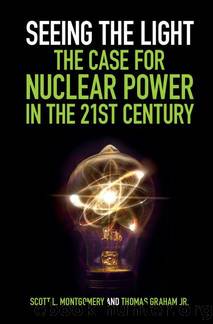Seeing the Light: The Case for Nuclear Power in the 21st Century by Graham Jr Thomas & Montgomery Scott L

Author:Graham, Jr, Thomas & Montgomery, Scott L. [Graham, Jr, Thomas]
Language: eng
Format: epub
Publisher: Cambridge University Press
Published: 2017-08-31T00:00:00+00:00
Bodega Bay and the Pattern of Protest
Debate and concern over the effects of fallout began to fade after the Limited Test Ban Treaty went into effect in 1963, forbidding above-ground testing. But the fears articulated by BEAR 1 did not die away with them. On the contrary. They had already found a new controversy in which to bloom.
This, the first protest against a nuclear power plant, took place at Bodega Bay, a sleepy and scenic fishing town of about 350 people some 45 miles (60 km) north of San Francisco and the site of Alfred Hitchcockâ s 1963 film, The Birds . In 1958, the California utility, Pacific Gas and Electric (PG&E), proposed building a power plant on a rocky headland bordering the bay, using eminent domain to acquire the land. It did not say what kind of plant it would build; it didnâ t announce this for three years.
Opposition began immediately from residents whose land was to be taken. It soon spread to others in the town who saw a large industrial installation as ruining the areaâ s pastoral beauty. Hearings before the California Public Utilities Commission ended with such concerns being dismissed. Residents were assured that PG&Eâ s scientists and engineers had everything in hand, and that the project would go forward. All requests for further hearings were denied. This lack of concern for the people who would be most directly affected did not sit well. Opposition changed to outrage.
In fact, there were two motives behind the plant. The state wanted more electricity to boost economic development, especially in the north. PG&E hoped to establish leadership in a brand-new market of nuclear power generation. The Utilities Commission and PG&E had discussed the idea of a power plant at Bodega Bay prior to any hearings. Though fairly common at the time, this kind of prelicensing exchange would soon be the target for accusations of collusion between regulating and regulated entities.
The protestors decided to expand their methods and recruit support from a variety of groups and individuals. Over time, and especially after it was announced that the power plant would be nuclear, the role of women proved pivotal. They were most effective in drawing into discussions and media conversations the national concern over fallout. What would happen if the nuclear plant had an accident? Couldnâ t it contaminate the milk from northern Californiaâ s dairy farms and poison children and families in surrounding areas [34 ]?
The enlarged opposition formed their own body, the Northern California Association to Preserve Bodega Head and Harbor. Activist spokespeople from San Francisco, University of California, Berkeley, conservation groups, and local towns began writing letters to major media outlets. In 1962, the group took its case to the AEC itself when PG&E made a formal application for the power plant. But the protestors discovered that only those with â recognized expertiseâ were allowed to speak. This did not include members of the general public.
At this point, the nature of the controversy shifted. Because the plant was
Download
This site does not store any files on its server. We only index and link to content provided by other sites. Please contact the content providers to delete copyright contents if any and email us, we'll remove relevant links or contents immediately.
Second Nature (The Shape-Shifter Series #1) by Jae(1054)
Petroleum Contracts by Peter Roberts(868)
The Global Commons by Susan J. Buck(865)
Infrastructure by Frischmann Brett M(811)
The Monk by Matthew Lewis(791)
Japan Travel Guide: Things I Wish I Knew Before Going To Japan (2019 EDITION) by Fukuyama Ken & Fukuyama Yuki(777)
Ever After by William Wharton(746)
Before Earth Day by Karl Boyd Brooks(716)
Good for You, Great for Me by Lawrence Susskind(709)
War of the Whales by Joshua Horwitz(686)
Biting the Hands that Feed Us by Baylen J. Linnekin(679)
Respecting Animals by David S. Favre(655)
Animal Law in a Nutshell by Frasch Pamela & Hessler Katherine & Waisman Sonia(654)
Uncommon Ground by William Cronon(653)
Rangeland Systems by David D. Briske(643)
After Nature: A Politics for the Anthropocene by Jedediah Purdy(641)
The Ethics of Space Exploration by James S.J. Schwartz & Tony Milligan(633)
Fracking the Neighborhood by Jessica Smartt Gullion(608)
Down to the Wire: Confronting Climate Collapse by David W. Orr(601)
